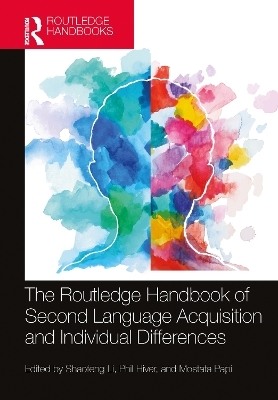
The Routledge Handbook of Second Language Acquisition and Individual Differences
Routledge (Verlag)
978-1-032-21914-1 (ISBN)
It goes beyond the traditional repertoire and includes 32 chapters covering a full spectrum of topics on learners’ cognitive, conative, affective, and demographic/sociocultural variation. The volume examines IDs from two perspectives: one is how each ID variable is associated with learning behaviors, processes, and outcomes; the other is how each domain of SLA, such as vocabulary or reading, is affected by clusters of ID variables. The volume also includes a section on the common methods used in ID research, including data elicitation instruments such as surveys, interviews, and psychometric testing, as well as methods of data analysis such as structural equation modeling.
The book is a must-read for any second language researcher or applied linguist interested in investigating the effects of IDs on language learning, and for any educator interested in taking account of learners’ individual differences to maximize the effects of second language instruction.
Shaofeng Li is Associate Professor of Foreign and Second Language Education at Florida State University, USA. Phil Hiver is Associate Professor of Foreign and Second Language Education at Florida State University, USA. Mostafa Papi is Associate Professor of Foreign and Second Language Education at Florida State University, USA.
Foreword Part 1 Introduction 1 Individual Differences in Second Language Acquisition: Theory, Research, and Practice Part 2 Cognitive Differences 2 Explicit and Implicit Language Aptitudes 3 Working Memory 4 Declarative and Procedural Memory as Predictors of Second Language Development 5 Learning Styles and Strategies 6 Metacognition Part 3 Conative Differences 7 Motivation 8 Mindsets 9 Goal Complexes 10 Willingness to Communicate Part 4 Affective Differences 11 Anxiety 12 Enjoyment 13 Self-Efficacy 14 Learner Beliefs Part 5 Sociocultural and Demographic Differences 15 Identity 16 Age Part 6 Individual Difference Factors for Aspects of Second Language Learning 17 Individual Difference Factors for Second Language Pronunciation 18 Individual Difference Factors for Second Language Vocabulary 19 Individual Difference Factors for Second Language Grammar 20 Individual Difference Factors for Second Language Pragmatics 21 Individual Difference Factors for Second Language Listening 22 Individual Difference Factors for Second Language Speaking 23 Individual Difference Factors for Second Language Reading 24 Individual Difference Factors for Second Language Writing Part 7 Research Methods 25 Surveys 26 Narrative Methods 27 Ethnography 28 Eye-Tracking 29 Psychometric Assessments 30 Measures of Implicit Attitudes 31 Methods for Complexity Theory in Individual Differences Research 32 Structural Equation Modeling and Factor Analysis
| Erscheinungsdatum | 12.05.2022 |
|---|---|
| Reihe/Serie | The Routledge Handbooks in Second Language Acquisition |
| Zusatzinfo | 15 Tables, black and white; 32 Line drawings, black and white; 32 Illustrations, black and white |
| Verlagsort | London |
| Sprache | englisch |
| Maße | 178 x 254 mm |
| Gewicht | 1056 g |
| Themenwelt | Schulbuch / Wörterbuch ► Wörterbuch / Fremdsprachen |
| Geisteswissenschaften ► Psychologie ► Allgemeine Psychologie | |
| Geisteswissenschaften ► Psychologie ► Entwicklungspsychologie | |
| Geisteswissenschaften ► Psychologie ► Verhaltenstherapie | |
| Geisteswissenschaften ► Sprach- / Literaturwissenschaft ► Sprachwissenschaft | |
| ISBN-10 | 1-032-21914-9 / 1032219149 |
| ISBN-13 | 978-1-032-21914-1 / 9781032219141 |
| Zustand | Neuware |
| Informationen gemäß Produktsicherheitsverordnung (GPSR) | |
| Haben Sie eine Frage zum Produkt? |
aus dem Bereich


